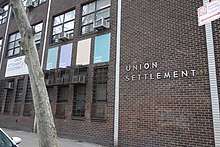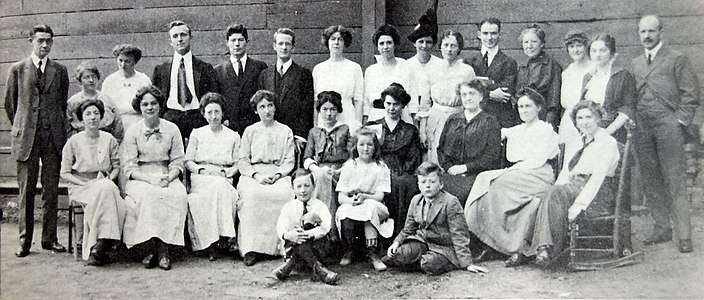Union Settlement Association
Union Settlement Association is one of the oldest settlement houses in New York City, providing community-based services and programs that support the immigrant and low-income residents of East Harlem since 1895. It is one of East Harlem’s largest social service agencies and serves more than 13,000 people annually at 17 locations, through programs including early childhood education, youth development, senior services, job training, the arts, adult education, nutrition, counseling, a farmers' market, community development, and neighborhood cultural events.
 The Gaylord White Community Center of the Union Settlement association (2015) | |
| Formation | 1895 |
|---|---|
| Purpose | Social reform |
| Location |
|
| Services | early childhood education, youth development, senior services, job training, arts programs, adult education, counseling, community development |
| Affiliations | Union Theological Seminary |
| Website | http://www.unionsettlement.org |
History
 Headworker Gaylord Starin White (far left) and the staff of Union Settlement in 1912.
Headworker Gaylord Starin White (far left) and the staff of Union Settlement in 1912.
Union Settlement was founded in 1895 by members of the Union Theological Seminary Alumni Club. After visiting Toynbee Hall in London, and inspired by the example of Hull House in Chicago, the alumni decided to create a settlement house in the area of Manhattan enclosed on the north and south by East 96th and 110th Streets and on the east and west by the East River and Central Park. Known as East Harlem, it was a neighborhood filled with new tenements but devoid of any civic services. The ethos of the settlement house movement called for its workers to “settle” in such neighborhoods in order to learn first-hand the problems of the residents. “It seemed to us that, as early settlers, we had a chance to grow up with the community and affect its development,” wrote William Adams Brown, Theology Professor, Union Theological Society (1892–1930) and President, Union Settlement Association (1915–1919).[1]
With millions of immigrants arriving in the Union States in the late 19th century as the two elevated subway lines were completed, East Harlem quickly equaled the Lower East Side as Manhattan’s predominantly immigrant community. Until the 1920s, it was New York’s true "Little Italy," claiming the largest population of Italians outside of Italy.[2] The neighborhood had a progressive, reformist commitment: Mayor Fiorello LaGuardia lived in East Harlem, spoke often at Union Settlement, and personified the political activism of the area.[3]
Union Settlement’s work has helped tens of thousands of children, youth and adults, many of whom have gone on to become leaders in the community and beyond, including New York Secretary of State Lorraine Cortes-Vazquez and City Council Member Robert Jackson. Hollywood movie star Burt Lancaster played sports, acted in theater productions and learned circus arts at Union Settlement as a boy. He credited Union Settlement for "saving him from the streets," and supported the organization all his life.[4]
In 1895 Union Settlement opened at 202 E. 96th Street, on the second floor of a tenement building. Union Theological Seminary student William E. McCord was appointed its first "headworker" (as its directors were known). It moved twice in 1895 (210 E. 104th Street and 237 E. 104th Street).[5]
In 1899, Morris K. Jesup purchased five houses (235-243 E. 104th Street) for the Settlement.[5]
In 1901, McCord resigned as headworker and Gaylord S. White replaced him, serving in that position for 22 years.[5]
In 1917, Union Settlement established three campgrounds in Palisades Interstate Park: Camp Nathan Hale for boys, Camp Gaylord White for girls and Camp Ellen Marvin for mothers and young children.[6] The camps exposed tens of thousands of inner-city youngsters, from 1917 to the 1960s, to the natural world.
In 1932, The New York Committee of the American Birth Control League opened a Birth Control Clinic at Union Settlement. The clinic is one of the first in the city and in East Harlem.
In 1957, Union Settlement Federal Credit Union opened its doors for business. The credit union is a financial cooperative where members pool their assets and lend money to each other at low interest rates.
In 1961, a $1 million Astor Foundation grant enabled Union Settlement and six other settlement houses to implement the Pre-Teen Delinquency Prevention Project.
In 1965, Union Settlement became the site of one of the country's first Head Start Programs, the federally sponsored preschool initiative launched as one of the Great Society undertakings.
In 1974, Settlement Health and Medical Services, part of a federal initiative, provided primary health care to East Harlem residents in a free-standing clinic. The program is separately incorporated in 1976.
In 1992, Union Settlement was selected to serve as the lead agency of the East Harlem HIV Care Network, a coalition of over 100 social and health service agencies that address issues of AIDS. Network members serve people who are HIV positive or are living with HIV/AIDS, and their relatives and partners
Programs
- Early Childhood Services: six childcare/Head Start centers and Family Childcare Network, pediatric asthma initiative, serving one-sixth of all childcare services in East Harlem.
- Youth Services: after-school and summer programs, computer classes, tutoring, sexual literacy, college readiness program, dance, theater, healthy living, counseling, workforce development (includes Rising Stars Program and Bridges)
- Adult Education: Basic Education in Spanish and English, English for Speakers of Other Languages, Civics, GED preparation, citizenship and computer classes, Writing Through Reading Program, home health aide training program
- Senior Services: five senior centers, Meals on Wheels, senior volunteer program, transportation program, senior fitness program
- Mental Health: individual, group and family counseling and psychotherapy, crisis intervention, Children’s Blended Case Management, geriatric mental health services
- AIDS/HIV Services: Manhattan HIV Care Network, HIV Counseling Program, training and workshops, community forums, Annual East Harlem AIDS Walk & Health Fair, participation in the National Latino AIDS Awareness Day
Community events
- Annual Day of the Dead Festival – Each year, Union Settlement hosts a popular Dia de Los Muertos celebration featuring artists, and musicians. Local children and families help create the altar, prepare traditional foods and participate in the festivities.
- Seasonal Farmers' Markets – Every Thursday from June through October on 104th Street between 2nd and 3rd Avenues
- Annual Ethnic Festival – A street fair and cultural festival on a Spring Saturday on 104th Street between 2nd and 3rd Avenues
References
- A Teacher and His Times, William Adams Brown, Scribner, 1940.
- Thomas Kessner, The Golden Door: Italian and Jewish Immigrant Mobility in New York City, 1880-1915, Oxford University Press, 1977.
- Kessner, Thomas (1989). Fiorello Le Guardia and the Making of Modern New York. New York: McGraw-Hill.
- Buford, Kate (2000). Burt Lancaster: An American Life. New York: Knopf.
- Kraus, Harry P (1980). The Settlement House Movement in New York City, 1886-1914. New York: Arno Press. 0405134347.
- Coffin, Harry S. (July 22, 1936). "To the Editor". New York Times. New York City, NY: New York Times.
External links
- Official website
- A timeline of Union Settlement’s history and historic photographs
- "Union Settlement Association records, 1896-1995". www.columbia.edu. A guide to archive holdings at the Rare Book & Manuscript Library, Columbia University, with a "Biographical Note" about Union Settlement's history.